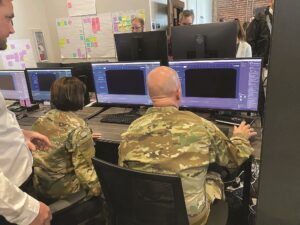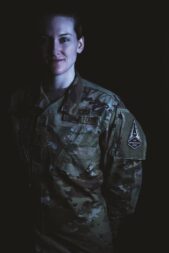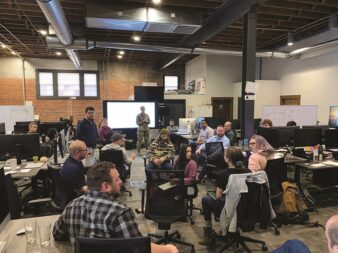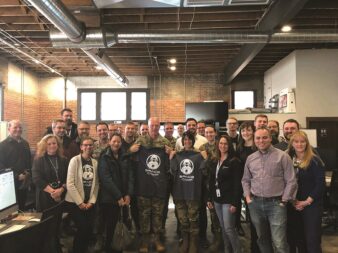To defend the high frontier, Space Force wants digitally minded troops
By Sandra Erwin

If fighter pilots are the rock stars of the Air Force, it could be said that software coders and app developers are the fighter jocks of the Space Force.
“Software touches everything we do in the Space Force,” said 1st Lt. Jackie Smith, who runs a Space Force software boot camp whose graduates are known as the “supra coders.”
Smith, an Air Force officer and software specialist who soon will be transferring to the Space Force, said 28 military and civilian personnel graduated from the first boot camp held in January.

The 28 were selected from among more than 300 candidates. The program is highly selective, Smith told SpaceNews. She noted that the name supra coders is in homage to the service’s motto Semper Supra, or always above.
The coding boot camps will become regular events as the Space Force looks to build a cadre of 400 software coders who will be assigned to units around the world that perform duties like space traffic control, satellite operations and space data analysis.
Chief of Space Operations Gen. John Raymond in a commander’s guidance document released in November calls for a digitally minded force that uses technology in innovative ways. The Space Force was established in December 2019 as an independent military branch to handle emerging national security threats in orbit such as anti-satellite weapons.
As soon as the Space Force was signed into law, Raymond pushed to have a senior post in his office dedicated to promoting technology and innovation. He selected Maj. Gen. Kimberly Crider as the Space Force chief technology and innovation officer, or CTIO. Crider previously was the Air Force’s chief data officer.
Gen. David Thompson, the vice chief of space operations, explained Crider’s role. “She is establishing a core set of knowledge and training activities that every single member of the Space Force will be required,” Thompson said last fall at a National Defense Industrial Association conference.
Crider said one of her responsibilities will be to develop guidelines for the use of data across all Space Force activities. “We want to utilize digital technologies and digital capabilities in all the things that we do and we want to develop a digital workforce,” she said at a conference of the American Institute of Aeronautics and Astronautics.
Smith, the software coder, was on an assignment at the Air Force Research Laboratory’s Space Vehicles Directorate in New Mexico when Crider tapped her to work at the CTIO office and help map the way forward.
“The supra coder program is part of our vision for a digital service,” Smith said. “We’re pushing to view software development as a strategic asset.”
Col. Charles Galbreath, the Space Force deputy CTIO, said his office plans to release more details on the Space Force’s digital strategy over the coming year.
This was a mandate from Raymond, said Galbreath. “Digital fluency is critical to all the guardians in the Space Force,” he said, referring to the name Space Force personnel were given in December.
Galbreath said there is no single definition of what it means to be a digital service. It’s about having a workforce proficient in software development and technology, but also about creating a culture where people are empowered to use data and technology to solve problems in creative ways.
The Space Force will set guidelines for the use of “digital engineering” in the design and acquisition of future satellites, said Galbreath. The goal is to design, develop and test satellites in virtual environments from end to end, a practice that is common in the private sector but the military has been slow to adopt because many organizations lack a modern information systems infrastructure.
To sharpen the workforce’s digital skills, the Space Force is taking advantage of the Department of the Air Force’s Digital University, a virtual school that offers courses such as digital product development, introduction to information technology infrastructure, data science and artificial intelligence, and cybersecurity.
Galbreath said so far more than 1,100 Space Force personnel have taken courses at Digital University.
“We don’t need everybody in the Space Force to be a coder,” he said. “But we do need everybody in the Space Force to have an understanding of the tools that are available to them” so they can be applied in their day-to-day operations.
Human capital strategy
The Space Force is by far the smallest of the military services. Numbering just a few thousand now, it expects to top out around 16,000 — about half active-duty military and half civilians. By comparison, the Marine Corps has about 180,000 personnel.
Because of its small size, the Space Force will have a technical focus and will rely on its parent service the U.S. Air Force for administrative support, training, base operations and other overhead functions.

Patricia Mulcahy, deputy chief of space operations for personnel and logistics, said the Space Force will concentrate its human capital on technical career fields like space operations, intelligence, cybersecurity, acquisition and engineering.
Speaking in January on a webinar hosted by the Aerospace Corporation’s Center for Space Policy and Strategy, Mulcahy said the Space Force has not yet set specific recruiting or hiring goals for each of the technical career fields because it is still transferring people from the Air Force.
More than 2,400 space operators from the Air Force have transferred so far and about 4,000 more will transfer over the coming year, said Mulcahy.
The Space Force for the first time in December received seven new enlisted members who graduated from the Air Force’s basic military training program. Mulcahy said all seven recruits were given iPads loaded with licenses for Digital University courses. Before they even started basic military training, the recruits collectively completed nearly 150 hours of courses, she said. “This tells us about the quality of folks we’re able to attract.”
About 300 more enlistees from basic military training are expected to join the Space Force this year. They will attend the Air Force’s space training school at Vandenberg Air Force Base, California, in order to become space systems operations specialists. Additionally, as many as 116 new officers will be added to the Space Force from the U.S. Air Force Academy class of 2021.
Mulcahy said the Space Force also will bring in some officers through Reserve Officers’ Training Corps programs at universities with focus on STEM degrees, short for science, technology, engineering and mathematics.
“It’s important to attract the best talent with the STEM background we need,” she said. “What you’ll see is emphasis on being digitally enabled. This is the very fabric of who we are.”
Fluency in programming languages, machine learning and data analysis are of crucial importance, said Mulcahy. “Space is a domain where the operator is not physically present so their ability to perform command and control, and space situational awareness is incumbent on a digital backbone,” she added.
Mulcahy said the Space Force is working on a human capital strategy to attract and retain technical talent.
Raymond and other Space Force leaders said they expect the service to become a magnet for tech-oriented young people. But the reality is that the Space Force will have to compete for talent with the private sector and with other government agencies, noted Paula Thornhill, a retired Air Force brigadier general who commanded the Air Force Institute of Technology at Wright-Patterson Air Force Base, Ohio.
It will be interesting to see the details of the Space Force human capital strategy, Thornhill said. Because of the rigid military personnel system, it seems unrealistic to expect the Space Force can populate the ranks with engineers and STEM experts, at least in the near term, Thornhill told SpaceNews. “A digital Space Force at this point is purely aspirational.”
Skills for space as domain of war
A digitally trained and skilled service is important to the future of the Space Force but so is a change in culture, said Gen. John Hyten, vice chairman of the Joint Chiefs of Staff and a career space officer.

The United States faces national security challenges as foreign powers develop space weapons to jam or disable critical satellites like the Global Positioning System, Hyten noted. Developing a workforce capable of dealing with these threats should be a top priority for the service, Hyten said during a webinar last month hosted by the National Security Space Association.
Space Force operators who are responsible to protect satellites in orbits thousands of miles above Earth have to be able to figure out that an attack might be underway and know how to respond, said Hyten. Traditionally space troops have been trained for routine operations of satellites and maintenance, not for hostilities, he added. In the future the Space Force will need troops who can think quickly on their feet.
“I see a big change coming over what has been a traditional space professional’s career,” Hyten said. “For decades it has really been a checklist oriented structured approach, operating a capability in a benign environment.”
The military space field is going in a different direction, he said. “You operate in a contested environment all the time, where you’re going to have different levels of responsibility in order to deal with the threat that presents itself.”
A guardian on a console flying a satellite must have the skills to see a threat but will also need authority to respond just like a private in combat is allowed to take certain actions without having to go through several layers of approvals, Hyten said. This will be part of a cultural evolution that will have to happen in the Space Force, which goes beyond the technical training.
Col. Richard Bourquin, commander of Space Delta 4 at Buckley Air Force Base, Colorado, cautions against putting too much emphasis on STEM degrees as a requirement to serve in the Space Force.
Space Delta 4 operates the satellites and ground radar that provide strategic and theater missile warning to the United States and international partners.
“We need diversity in the Space Force,” he said in a December interview with the Space Force Association.
“I worry a little bit when I hear people talk about the importance of STEM education,” said Bourquin. STEM fluency is needed, he pointed out. “But my concern is: does that automatically exclude people who haven’t had that opportunity or pursued other opportunities? Are we creating a single model of space professional? If they all grow up thinking the same we’re not going to be as effective.”
The Space Force is doing a good thing by promoting STEM education, he said. “But we have to be careful that we’re not just trying to create an army of clones that eventually all think the same.”
The service needs “people with agility of thought” who can quickly analyze a situation and come up with solutions if, for example, a satellite is being deliberately targeted.
To illustrate that point, Bourquin recalled when he was a junior officer flying Defense Support Program missile-warning satellites. “I got the data, I analyzed it. We’re great at that,” he said. “But if somebody was attacking the satellite I would not have known where to start or what was out there that could threaten the satellites.”
The up-and-coming space operators will have to prepare for those eventualities, he said. “I never knew anything about satellites maneuvering towards each other, or about rendezvous and proximity operations. We didn’t learn that.”
This article originally appeared in the Feb. 15, 2021 issue of SpaceNews magazine.
February 22, 2021 at 06:44PM
via SpaceNews read more...

Post a Comment